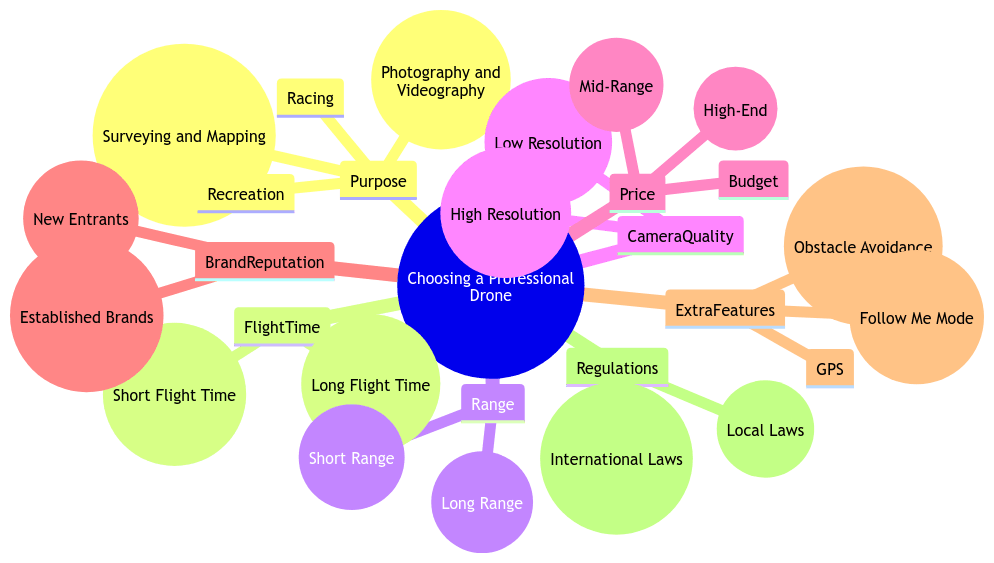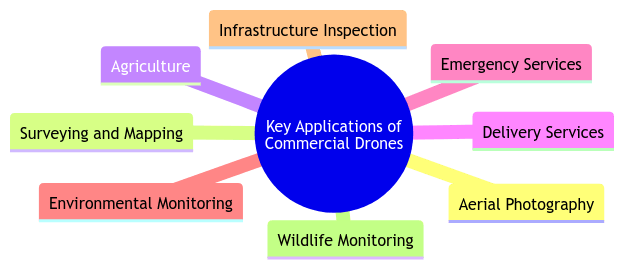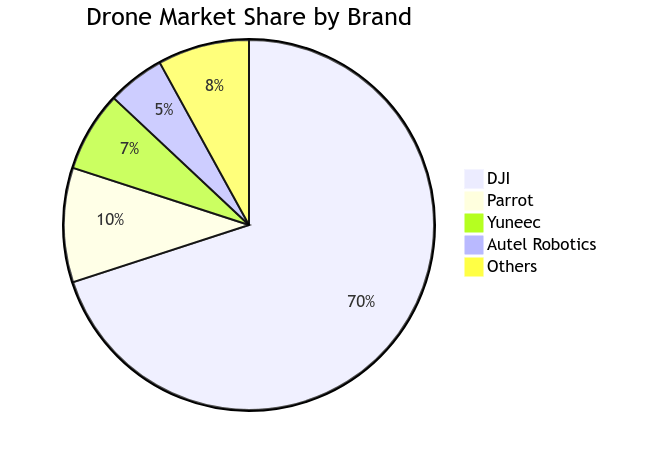Introduction
Drones have come a long way from being just a hobbyist’s gadget to becoming a crucial tool in various professional fields. With the right blend of quality and affordability, professional drones are now more accessible than ever before. This article will discuss the essential features to look for in a professional drone, showcase the top drones in the market, explore their applications, and provide tips for making the right purchase decision.
Factors to Consider When Choosing a Professional Drone

- Purpose: The purpose of the drone is a significant factor. The requirements for a drone used for photography and videography would be different from a drone used for surveying and mapping, racing, or recreation.
- Flight Time: The flight time of the drone is crucial. Some drones offer a short flight time, while others can fly for a longer duration. The choice depends on the specific needs of the user.
- Range: The range of the drone refers to how far it can fly from the controller. Some drones have a short range, while others can fly long distances.
- Camera Quality: The quality of the camera is important, especially for drones used for photography and videography. Some drones come with low-resolution cameras, while others offer high-resolution imaging capabilities.
- Price: Drones come in various price ranges. There are budget options, mid-range drones, and high-end drones. The choice depends on the user’s budget and the features they require.
- Brand Reputation: The reputation of the brand is another important factor. Established brands are often more reliable and offer better customer service. However, some new entrants in the market also offer innovative and high-quality products.
- Extra Features: Some drones come with extra features like GPS, obstacle avoidance, and a ‘follow me’ mode. These features can add to the functionality and ease of use of the drone.
- Regulations: It’s important to consider local and international laws related to drone usage. These regulations can affect where and how the drone can be used.
Each of these factors plays a crucial role in determining the best drone for a particular user’s needs. It’s important to consider all these factors before making a purchase decision.
Top Professional Drones
1. PowerVision PowerEgg X Wizard Waterproof Drone
The PowerVision PowerEgg X Wizard Waterproof Drone is a versatile and unique drone that stands out due to its waterproof design and ability to land on water. This feature, along with the included waterproof housing, makes it ideal for aquatic activities, such as boating, fishing, or water sports.
The drone is equipped with a 4K UHD camera, providing high-quality images and videos. It also boasts a 30-minute flight time and a range of up to 3.7 miles (6 kilometers), allowing for extensive aerial coverage. The PowerEgg X Wizard comes with multiple intelligent flight modes, including subject tracking and gesture control, making it user-friendly and suitable for various applications.
Customer reviews highlight the drone’s stability and ease of use, as well as its impressive waterproof capabilities. Some users have mentioned the relatively short battery life as a drawback, but overall, the PowerEgg X Wizard has received positive feedback.
Pros
- Unique waterproof design
- Can land on water
- 4K UHD camera
- Multiple intelligent flight modes
Cons
- Relatively short battery life
- Limited range compared to other professional drones
2. Autel Robotics EVO 2 Pro V3 Drone
The Autel Robotics EVO 2 Pro V3 Drone is designed for professional photography and videography, featuring a 6K resolution camera with an adjustable aperture. Users appreciate the drone’s 40-minute flight time, which provides ample time to capture stunning visuals.
One of the key features of the EVO 2 Pro V3 is its omnidirectional obstacle avoidance system, ensuring safe flights and reducing the risk of accidents. The drone also has a 5.6-mile (9 km) video transmission range and Dynamic Track 2.0 for advanced subject tracking.
Customers have praised the EVO 2 Pro V3 for its image quality, flight stability, and ease of use. However, some users reported difficulties with customer support and firmware updates.
Pros
- 6K resolution camera with adjustable aperture
- 40-minute flight time
- Omnidirectional obstacle avoidance
- Dynamic Track 2.0
Cons
- Reported issues with customer support
- Occasional firmware update difficulties
3. DJI Avata Pro
The DJI Avata Pro is a reliable and compact drone, known for its user-friendly design and excellent camera capabilities. Equipped with a 4K camera that features a 3-axis gimbal, the Avata Pro ensures stable footage and high-quality images.
With a 30-minute flight time and a range of up to 4.3 miles (7 km), this drone provides ample opportunities for capturing stunning aerial views. The drone also includes multiple intelligent flight modes such as ActiveTrack, Tripod Mode, and Gesture Mode, making it suitable for various applications.
Customers have praised the DJI Avata Pro for its portability, ease of use, and impressive image quality. Some users mentioned issues with the DJI app, but overall, the drone has received positive feedback.
Pros
- Compact and portable design
- 4K camera with 3-axis gimbal
- 30-minute flight time
- Multiple intelligent flight modes
Cons
- Occasional issues with the DJI app
- Limited obstacle avoidance capabilities
4. DJI FPV Combo
The DJI FPV Combo is an innovative drone that offers an immersive first-person view (FPV) experience. With its high-speed performance and 4K/60fps camera, this drone is ideal for capturing dynamic footage and enjoying exhilarating flights.
The FPV Combo features a 10km (6.2 miles) video transmission range and a 20-minute flight time. Its advanced stabilization system, the DJI FPV Goggles V2, and the DJI Motion Controller provide an unparalleled flying experience.
Customers appreciate the DJI FPV Combo for its immersive experience, high-speed capabilities, and unique design. However, some users have mentioned the drone’s steep learning curve and the need for extra batteries to extend flight time.
Pros
- Immersive FPV experience
- High-speed performance
- 4K/60fps camera
- Advanced stabilization system
Cons
- Steep learning curve
- Relatively short flight time
5. DJI Mavic 2 PRO Drone
The DJI Mavic 2 PRO is a popular choice among professional photographers and videographers, thanks to its exceptional camera capabilities. Featuring a 1-inch 20MP Hasselblad sensor, the drone captures stunning images and videos in 4K resolution.
With a flight time of up to 31 minutes and a range of 5 miles (8 km), the Mavic 2 PRO allows users to cover vast areas during aerial shoots. The drone also includes advanced features such as omnidirectional obstacle sensing, ActiveTrack 2.0, and Hyperlapse mode.
Customers have lauded the DJI Mavic 2 PRO for its image quality, portability, and advanced features. Some users reported issues with the geofencing system, but overall, the Mavic 2 PRO has received overwhelmingly positive reviews.
Pros
- 1-inch 20MP Hasselblad sensor
- 31-minute flight time
- Omnidirectional obstacle sensing
- Multiple intelligent flight modes
Cons
- Issues with the geofencing system
- Higher price point compared to other drones
6. DJI Air 2S Fly More Combo
The DJI Air 2S Fly More Combo is a powerful and portable drone designed for enthusiasts and professionals alike. Featuring a 1-inch 20MP sensor, the drone captures stunning images and videos in 5.4K resolution.
With a flight time of up to 31 minutes and a range of 7.5 miles (12 km), the Air 2S allows users to explore vast areas during their aerial adventures. The drone also boasts advanced features such as ActiveTrack 4.0, APAS 4.0 obstacle avoidance, and FocusTrack, making it suitable for a variety of applications.
The Fly More Combo includes additional accessories such as extra batteries, ND filters, and a carrying case, offering great value for users who want to maximize their drone experience.
Customers have praised the DJI Air 2S Fly More Combo for its image quality, portability, and user-friendly design. Some users mentioned the need for a more comprehensive instruction manual, but overall, the Air 2S has received positive feedback.
Pros
- 1-inch 20MP sensor with 5.4K resolution
- 31-minute flight time
- Advanced features such as ActiveTrack 4.0 and APAS 4.0 obstacle avoidance
- Fly More Combo offers great value
Cons
- Limited instruction manual
- Slightly higher price point for the Fly More Combo
History of Drones

- 1907 – First Quadcopter: The first quadcopter was invented in 1907, although it was not fully functional. It was able to lift off the ground but required a person to control it from the ground.
- 1915 – First Drone Used in War: During World War I, the concept of unmanned aerial vehicles (UAVs) was introduced for military purposes. These early drones were essentially pilotless aircraft used for target practice.
- 1980s – Military Drones: In the 1980s, drones started to take on more complex roles within the military. They were used for surveillance, intelligence gathering, and even as decoys in combat situations.
- 2006 – Commercial Drones: The use of drones expanded beyond the military in 2006 when the Federal Aviation Administration (FAA) issued the first commercial drone permit.
- 2010s – Consumer Drones: In the 2010s, drones became widely available to the general public. These consumer drones are often used for photography, videography, and recreational flying.
Key Applications of Commercial Drones

Aerial Photography: Drones are widely used for aerial photography in various fields such as real estate, tourism, and film production. They can capture stunning overhead shots that were previously only possible with a helicopter or airplane.
Surveying and Mapping: Drones equipped with GPS and imaging technologies can quickly and accurately survey large areas of land, making them invaluable tools for topographic mapping, construction site planning, and land management.
Agriculture: In agriculture, drones can monitor crop health, track livestock, and even assist in planting and spraying crops. This can lead to increased efficiency and yield.
Delivery Services: Companies like Amazon and Google are exploring the use of drones for delivering small packages, which could revolutionize the e-commerce industry.
Emergency Services: Drones can be used in search and rescue operations, fire monitoring, and disaster response. They can reach areas that are difficult or dangerous for humans to access.
Environmental Monitoring: Drones can monitor environmental conditions and changes over time, such as deforestation, wildlife populations, and pollution levels.
Infrastructure Inspection: Drones can safely inspect infrastructure such as bridges, power lines, and wind turbines, reducing the risk to human inspectors and increasing efficiency.
Wildlife Monitoring: Drones can monitor wildlife populations without disturbing the animals, making them useful tools for conservation efforts.

Regulations and Licensing for Professional Drones
Before operating a professional drone, familiarize yourself with the local regulations and licensing requirements. In many countries, a license or certification is required for commercial drone use. Ensure you adhere to these guidelines and maintain safe flying practices.
Drone Accessories for Enhanced Performance
Invest in drone accessories to improve performance and extend capabilities. Additional batteries, high-capacity memory cards, and specialized payloads, such as thermal or LiDAR sensors, can enhance your drone’s functionality.
Future of Commercial Drones
As drone technology continues to advance, we can expect further improvements in capabilities, such as increased autonomy, longer flight times, and better payload capacities. This will pave the way for new and innovative applications in various industries.
Conclusion
Selecting the right professional drone is crucial for achieving success in commercial applications. By considering factors such as camera quality, flight time, stability, and ease of use, you can choose the best drone to meet your needs. The top professional drones discussed in this article offer powerful features, making them ideal choices for various industries and applications.
FAQs
The DJI Air 2S and Autel Robotics EVO Lite+ are excellent choices for photography and videography, thanks to their high-resolution cameras and advanced flight features.
Most professional drones come with advanced stabilization features and intelligent flight modes, making them relatively easy to fly even for beginners.
In many countries, you may need a license or certification to fly a professional drone for commercial purposes. Always check your local regulations before flying.
Some professional drones have weather resistance features, but it’s best to avoid flying in extreme weather conditions to ensure the safety of both the drone and the operator.
To extend the flight time of your professional drone, consider investing in additional batteries and swapping them out during operations. Also, ensure that you maintain your drone properly by keeping the batteries in good condition and following the manufacturer’s guidelines for optimal performance.
Regular maintenance is essential to keep your professional drone in good working condition. This includes cleaning the drone, inspecting for any damage, calibrating sensors, updating firmware, and ensuring that the batteries are in good health.
Some professional drones can be used indoors, provided they are equipped with the necessary sensors and features, such as obstacle avoidance and precise positioning systems. However, it’s essential to exercise caution and follow safety guidelines when flying indoors.







Leave a Reply